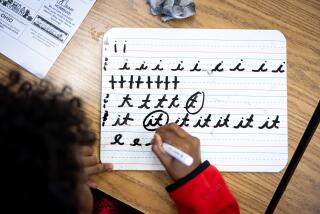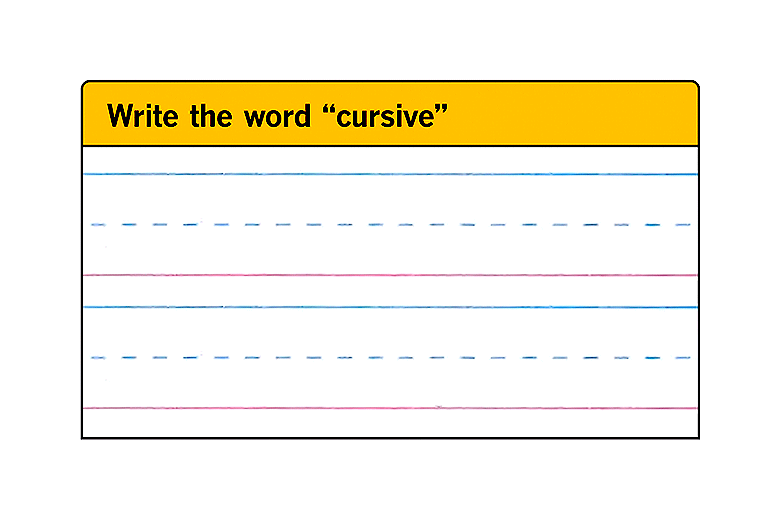Mime Leads Kids to Way With Words
- Share via
Richard Shope is borrowing a centuries-old art form to help today’s generation write better tomorrow.
Shope, 33, believes there’s a strong link between mime--the art of communicating through silent movement and gesture--and the written word.
To be good at either requires an eye for detail and an ability to capture it. A mime does it with movement, a writer with words. While the means are different, the aim is the same: the presentation of a clear, concise image.
But Shope, a playwright and accomplished mime, contends much of what elementary and high school students compose today is shallow and unimaginative--shortcomings the founder of the Marina del Rey-based company, Mime Media, believes he can correct.
His prescription is a bit unorthodox, but hugely popular with students, teachers and administrators who have tried it. Shope, in costume and mime makeup, goes to a school, performs before an assembly or a class, and then challenges students to describe his actions, at first verbally, and then in writing. When they finish, students read the compositions aloud, while classmates act out the story line under Shope’s watchful eye.
Exercise in Developing Imagination
It is an exercise in observation, recall and imagination--skills that Shope contends are no longer valued--or used--by a generation weaned on television, video games and MTV.
“The aim is to improve a child’s power of imagination,” said Shope, who launched his mime writing project three years ago, working largely in Los Angeles city schools before expanding into suburban districts, such as the El Rancho Unified School District in Pico Rivera, where he is going from school to school this month, performing and lecturing.
Rio Vista Elementary School was his first stop in the El Rancho district.
When the tall, lanky Shope stepped into Room 22, he towered over the fourth- and fifth-graders. The children’s eyes were glued to Shope’s every move, fixated by his costume--his ruby-red blouse, his black leather pants, sequined leg warmers and makeup, a layer of white covering his face. Two hearts, one broken, were painted on his cheeks.
After miming a person climbing stairs and walking in the wind, he turned and faced the black board.
When he wheeled and looked at the students there wasn’t a sound. His hands, rigid and vertical, were in front of him. They were spread as wide as a breadbox. Slowly, he moved his right hand up, and then horizontally across the top of the imaginary box. He then raised the lid, and peered inside, his eyes rolling from side to side.
“What is this, class?” Shope asked.
The response was unanimous, “a box.”
“Good. Now, I want each of you to pass this box, first opening it, and then showing us what’s inside,” Shope said handing the box to a little girl in the first row.
One by one, the imaginary box moved around the room, the children’s small hands giving it shape as they set it on their desks.
One boy pulled out a baseball, cupping his hands in a circle and tossing it to Shope, who caught it and pitched it back. Another boy found a toothbrush, while the girl next to him lifted a crown out of the box and placed in it on her blonde hair.
Skit Ends Exercise
“When they explore that box, I want them to pull out an object that has size, dimension and shape,” Shope said after class ended. “But they have to show us. They can’t tell us. That way they have to think about it, imagine what it looks like first, but showing us. It’s the same process when you write.”
The exercise ended with Shope acting out a short skit about a man who gets lost in a storm and then finds a deserted house that he enters to escape the cold. Once inside, he finds a large box. The children had to write an ending for the story, describing what was in the box.
“He really makes me think about things,” said Jerry Rodriquez, 10, who wrote that the man found “hundreds and thousands of dollars” in the box, but only took $5, which he used to buy an umbrella at the Salvation Army. “He’s helped me a lot to see things.”
Shope describes himself as a “catalyst, an outsider who is trying to motivate the kids and equip teachers with a new way to approach an old problem--getting kids to write well.”
In many ways, he said it’s tougher today to get children “curious about learning.”
That’s why, Shope said, the mime approach works. “They get caught up and before they know it they are learning how to be more expressive, descriptive and observant.”
Facial Expressions
Another of Shope’s lessons, for example, focuses entirely on facial expressions. On the blackboard he might list three moods: sad, happy and angry. He then acts out the moods, and the children must describe which actions are associated with what mood.
“I don’t want them to simply say he looks sad,” said Shope, who got started in mime in 1971 when he left the University of Minnesota and joined Minneapolis’ Urban Arts Program as an actor and instructor.
“I want them to describe why he looks sad--he’s frowning, his shoulders are drooping and his head is down. That evokes a clearer image in the reader’s mind.”
The marriage of mime and writing was born out of a series of meetings in 1982 between Shope and Allyn Arnold, the longtime coordinator of programs for gifted and talented students in the Los Angeles Unified School District.
Since the late 1960s, Arnold had been experimenting with the arts, such as drama and improvisation, as a teaching tool, particularly for the district’s best and brightest students. Mime was part of the program, but it wasn’t until Arnold met Shope--a student of renowned French mime Marcel Marceau--that it became a major component.
Results’ Phenomenal’
“The results were phenomenal,” Arnold said. “Almost overnight, students who had never taken an interest in any phase of school, were suddenly clamoring to get involved. Shope has an instinctiveness that makes him a natural as teacher. The kids turned on to him. It was instantaneous. Writing suddenly took on a whole new meaning for those kids.”
Since then, Shope estimates he has performed for more than 15,000 students in schools from from San Diego to the San Fernando Valley. He charges $32 an hour to lecture, and $225 to perform at a school assembly, though the rate is lower when he is hired for a series of sessions.
Because he works alone and can’t visit all schools, Shope has designed a mime writing program for elementary and high school students.
Sometime this spring, Shope said the package--a 24-step lesson plan and an accompanying two-hour video of mime moves--should be completed and available for school districts.
More to Read
The biggest entertainment stories
Get our big stories about Hollywood, film, television, music, arts, culture and more right in your inbox as soon as they publish.
You may occasionally receive promotional content from the Los Angeles Times.










